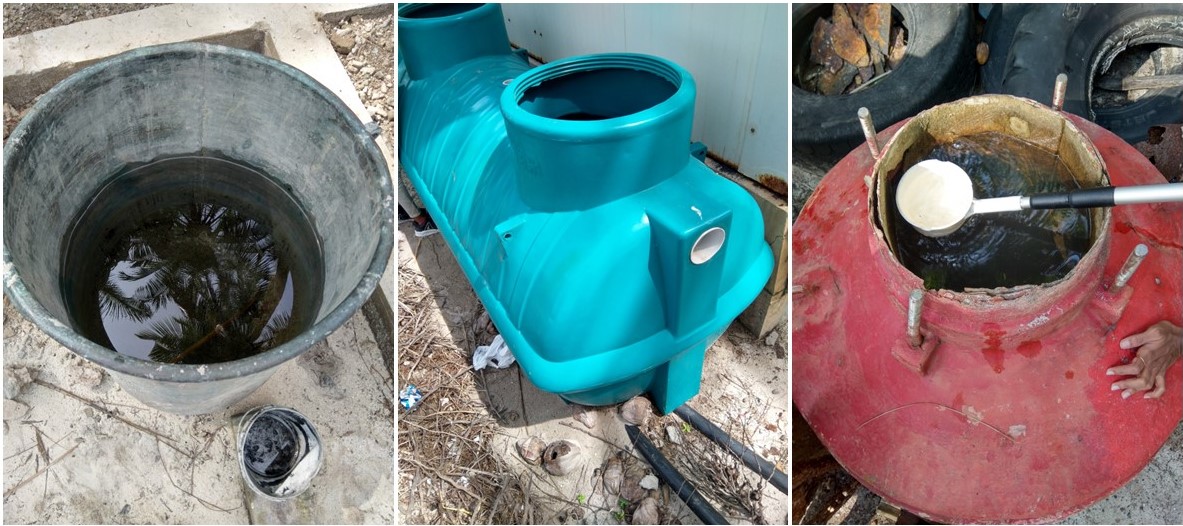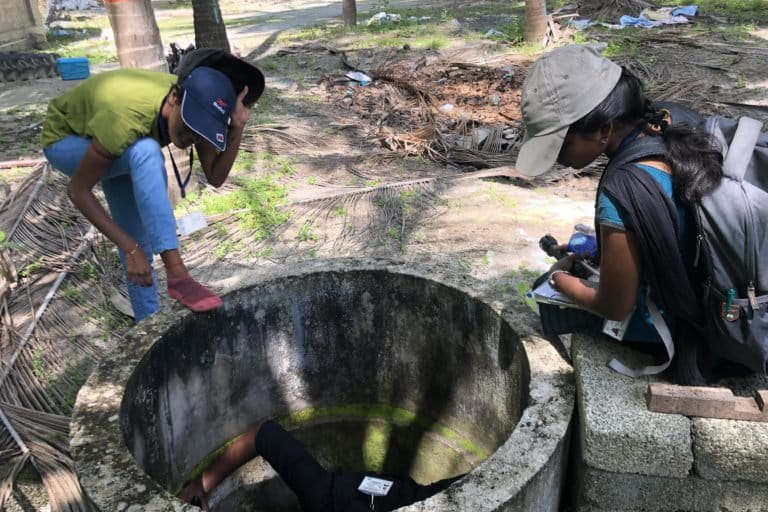- Human-made artificial habitats such as dumped plastic containers on the Lakshadweep islands are leading to a profusion of Aedes mosquitoes that cause dengue, chikungunya and other diseases, according to a recent study.
- The study finds Aedes albopictus is above the dengue epidemic threshold with a greater risk of dengue transmission in the islands but not Aedes aegypti.
- Vector control strategies targeting plastic pollution from household waste in these islands are needed on the islands
Between October 2019 and January 2020, a group of mosquito hunters was carefully nurturing mosquito larvae in makeshift labs on the Lakshadweep archipelago in the Arabian Sea, patiently waiting until they emerged. These larvae lurked in a variety of natural and artificial habitats that store water, such as coconut shells, tree holes, discarded plastic containers, discarded utensils, tyres, boats and even grinding stones.
Once the larvae emerged, and following sampling of adult mosquitoes, these mosquito hunters – researchers at Tata Institute for Genetics and Society – were able to offer a clearer picture of what transpires on these remote oceanic islands as plastic trash creates more breeding grounds for mosquitoes.
The Aedes species of mosquitoes, responsible for dengue, chikungunya, Zika fever, and other vector-borne diseases, were thriving very well in the dumped plastic containers where rainwater accumulated. “These (containers) were mainly trash generated within the local communities and were abundant. The water conditions are also optimum. The Aedes species do not need deep water surfaces to breed, they usually breed in shallow holdings or drums, etc.,” says evolutionary ecologist Farah Ishtiaq, the corresponding author of the study documenting the findings.

These human-made habitats are mainly contributing to the high abundance of Aedes species, says Ishtiaq cautioning that while Aedes albopictus is above the dengue epidemic threshold with a greater risk of dengue transmission in the islands, the Aedes aegypti species is not. The study provides baseline information needed to devise mosquito control strategies, targetting plastic pollution from household waste in these islands, which is a critical driver of disease risk but a risk that can be managed.
“The solution is simple. Once you know that these are the sites where these mosquitoes are breeding, you remove them and you manage the waste (discarded plastic containers and other potential mosquito habitats) so that these items don’t pile up creating habitats for the mosquitoes,” added Ishtiaq.
The team recorded a total of 7,890 mosquitoes representing 13 species and 7 genera across 10 inhabited islands. Of these, four species comprised 95% of the total collections — Aedes albopictus (Stegomyia) was the dominant species followed by Armigeres subalbatus, Culex quinquefasciatus and Malaya genurostris.
The Ae. Albopictus and Cx. quinquefasciatus mosquito species are primary vectors of arboviruses and Ar. subalbatus, incriminated as a vector of Japanese encephalitis virus and filariasis and are well adapted to thrive in both natural and artificial habitats. “Lakshadweep has had dengue and chikungunya outbreaks in the past. Anopheles stephensi (urban malaria vector) has colonised recently and if it thrives well, malaria can be a risk,” Ishtiaq said. The mosquito species recorded by the team are mostly found in mainland India and have probably colonised these islands.

Research assistant P.D. Rohini, who was part of the 2019-2020 survey, describes the ubiquitous presence of Aedes mosquitoes during the survey work: every household they visited for sampling mosquitoes would tell them of their presence and in islands like Minicoy, they would be “surrounded by mosquitoes” even with precautions. “All coconut shells would have larvae, for example. And local communities were aware of their presence but they need better sensitisation of the risk of disease transmission,” Rohini adds.
Public health scientist Ramesh Dhiman, who was not associated with the survey, says the strategies for control of mosquito-borne diseases are well defined by the National Center for Vector Borne Diseases Control.
“The strategy of vector control is similar to strategies on the mainland. Do not let the discarded material like plastic containers, discarded tyres be thrown anywhere on the islands. The community should not let water accumulate in damaged boats, cement tanks, open syntax tanks, etc. Water stored in households should be covered with a proper lid. The water containers should be emptied every 5-6 days,” Dhiman said.
“Since Lakshadweep islands have limited population, entry should be monitored, i.e. persons having fever should not be allowed to travel or they should have negative report of malaria and /or dengue,” Dhiman, former principal investigator at DST- ICMR Centre of Excellence for Climate Change and Vector-Borne Diseases ICMR-National Institute of Malaria Research, told Mongabay-India.
Concerns on disease transmission risk from Aedes species were also raised earlier. In a 2017-2018 surveillance study, researchers documented 16 species of mosquitoes from nine islands, with six of these species recognised as vectors in India. “We also found Aedes sp. breeding in coconut shells, discarded plastic containers, cement tanks, unused wells, plastic water storage tanks, unused boats, and discarded washing machines (in the 2017-2018 study),” says K. Jayalakshmi at the Central University of Tamil Nadu, who is also a co-author on the current study documenting the 2019-2020 survey.
A 2000 survey published in World Health Organisation’s 2001 Dengue Bulletin documented five mosquito species An. stephensi, An. varuna, Cx. quinquefasciatus, Aedes albopictus and Aedes aegypti, across Kavaratti and Agatti in Lakshadweep. It warned about the invasion of An. stephensi on Lakshadweep, driven mainly by its ability to fit in with the “community’s social and cultural habits like water storage in small cement tanks, rainwater harvesting tanks etc.” Aedes sp. also made these tanks, tyres, and metallic containers that hold rainwater and tree holes, their home.

The presence of Aedes aegypti was recorded in Minicoy islands in 1974 which subsequently invaded other islands. As for the Anopheles species, Anopheles varuna came to the islands from Kerala and occupied draw-wells as their breeding sites. Anopheles tesselatus was introduced to Lakshadweep from the Maldives and maintained low-grade transmission fever; however, these species failed to gain a foothold in the Lakshadweep islands, the 2001 WHO report states.
Given the environmental conditions are favorable, it takes several generations for a mosquito species to successfully colonise a new location to the levels of abundance that allow for detection during active surveillance. So it is likely that Aedes mosquitoes may have come into Lakshadweep before these surveys. Farah Ishtiaq and her team are working on genomics to better understand the colonisation of the Lakshadweep islands by Aedes species.
“It takes a while for a vector species to arrive in a new site and establish before it becomes so abundant that it becomes a dominant vector in that area responsible for disease transmission. And many species remain undetected despite active surveillance. In the United States, for example, genetic analyses of Aedes aegypti, revealed that the California population had been around at least 30 years prior to its discovery in 2013,” says Ishtiaq.
Dhiman cautioned against the extended indigenous transmission (community transmission) of dengue or malaria but said climate change is not likely to affect the transmission immediately as the climatic conditions are already suitable for transmission of malaria and dengue. “However, detailed analysis is desired to find out the changes in temperature and relative humidity to know whether the transmission months are likely to extend,” he added.
Banner image: A heap of discarded plastic containers in one of the sites surveyed by the team. Photo by P.D. Rohini and G. Sutharsan.
